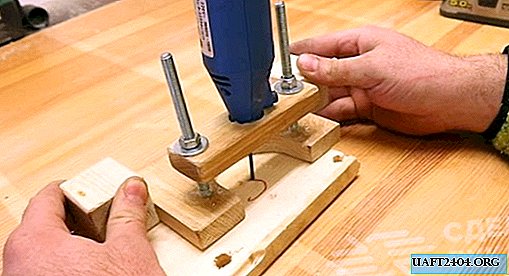Share
Pin
Tweet
Send
Share
Send

You will need:
- Plywood 12 mm thick.
- Thick board (40-50 mm).
- Hardware.
- PVA glue.
Manufacturing process
From the plywood with a jigsaw or on a circular saw, we cut out the bottom of the carriage, the width of a table of a circular saw and a depth of about 40 cm. From hardwood (in this case beech), we make circular guides in the size of the grooves of the table and fix them on glue and screws.

We adjust the width of the runners under the grooves so that the base of the carriage slides freely, but without transverse backlashes. To do this, initially the skids can be made exactly to the width of the grooves, and then with the help of sandpaper to achieve a smooth glide.

Now you need to make the front and back slats of the carriage. From a board or from plywood glued in half, we make the back bar (width - at the base, height - arbitrary). It carries a purely mechanical function and does not require particularly precise fastening. We fix it from the bottom to glue and self-tapping screws and make the first COMPLETE cut, without bringing it to the front edge by several centimeters.

From a thick board or plywood glued in half, we make the front bar (width - at the base, height 15 cm). Its feature is that on top we make a T-groove under the head of the M8 bolt. To do this, first make a blank cut on a circular saw. Its depth should be slightly larger than the height of the bolt head, and the width should be slightly larger than the distance between two parallel faces of the hexagon of the bolt head. In this case, the carriage for the circular is also made on the circular, without the help of a milling cutter.

Then, on top of the resulting groove for glue and screws, we mount a bar of plywood.

And we make a cut in it with a width of 8 mm - just under the diameter of the M8 bolt.

We attach the front bar to the base for glue and screws.
ATTENTION: we monitor compliance with right angles with respect to a previously made cut and with respect to the plane of the base of the carriage!

Now the base of the carriage can be cut to the end. And as a security element from the scraps of plywood, we make a fence where the saw blade will go when cutting.

The carriage itself is ready. It is necessary to make two hinged stops, shuttle and caliber.
The emphasis is two blanks made of plywood, assembled on glue and screws at a right angle. The emphasis is conveniently mounted using the front bracket of the carriage as a base with an angle of 90 degrees. In this case, the installation site must first be pasted with tape so that the stop parts do not stick to the carriage rail. After drying, the adhesive tape must be removed. In this way, we make two stops and drill two holes for the M8 bolts in their upper part.

We make the shuttle 25x15 cm in size from double-glued plywood and a wooden plank 16 mm wide, 5 mm high and arbitrary length, in this example about 80 mm. We glue the bar flush with the bottom edge of the shuttle into a pre-selected groove.
We make a caliber from the same bar 16 wide and 5 mm high. On the one hand, we leave a width of 16 mm, and on the other, it is reduced by the cut width h.

Everything is ready to test the manufacture of box joints. First we set the shuttle so that the edge of the tongue is located from the saw blade at a caliber distance of 16 mm wide. Thus, we set the parameters for the future spike-groove connection: the spike width will be 16 mm, and the groove size will also be 16 mm. We push the emphasis B to the shuttle and fix it with wing nuts.

To find the position for the stop A, we use the second side of the caliber, having the width of the tongue, reduced by the thickness of the cut saw blade. We fix emphasis A.

We release the saw blade to the height of the material used. In this example, pieces of plywood 10 mm thick are taken. That is, we raise the saw blade above the base of the carriage by 10 mm. We move the shuttle close to the stop B, abut the workpiece in the tongue and make the first extreme cut.

We move the shuttle to the stop A, abut the workpiece in the tongue and make the second extreme cut.

Then we gradually shift the shuttle and select the wood between the extreme cuts.

Thus, a groove is formed with a depth of 10 mm and a width of 16 mm. We throw the workpiece with a groove on the hook tongue, and repeating the steps to form the extreme cuts and select the wood between them, we make the second groove and subsequent grooves until the end of the workpiece. If the last groove is not a multiple of the length of the workpiece - no big deal.

We turn the workpiece 180 degrees, put the first whole groove on the tongue, push the shuttle to the stop B, substitute the second mating part from plywood and make the first cut.

We remove the first part and make the grooves on the second, as described above.

We match the resulting details and make sure that the box connection is made correctly.

Conclusion
It turned out a convenient universal carriage, which can successfully replace a miter saw. Also, using this carriage, you can make a thorn-groove box connection or make decorative lattices.
Share
Pin
Tweet
Send
Share
Send











